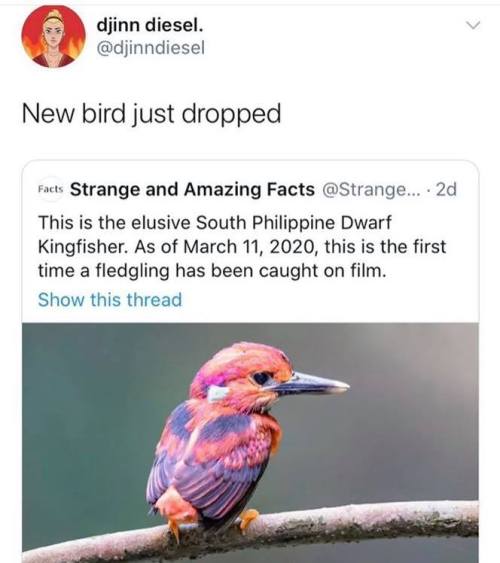Vnrgaard - Untitled









More Posts from Vnrgaard and Others








Nam Joohyuk // ELLE Magazine March Issue “Midnight in LA”
in addition to the fact that people just have different natural rhythms, a big reason why we can’t seem to go to bed as early as we “should” is that nighttime is, for many of us, our safest and most fulfilling time of day. we don’t have to work, we won’t be contacted by bosses or insurance companies or collections agencies or other suffocating life business… we’re likely only to be contacted by our friends, or by no one at all. night time is release; it’s ours. we can rest or recreate. we can do things we actually want to do. who would choose to cut that short?? just to usher in the next morning when our lives are not our own again? nighttime is precious and nothing could be more normal than the desire to embrace this


PARENTS and ANXIETY | Psych2Go
Can daddy yankee just contact him for a collab already

I find myself opposed to the view of knowledge as a passive copy of reality.
- Jean Piaget 1896-1980
How do we learn things? The answers to this age-old question have been examined and analysed by many scientists. There are plenty of prominent theories explaining cognitive development and helping us to understand the foundation of knowledge.
One of the most prominent answers to the question has come from a Swiss psychologist, Jean Piaget.
The legacy of Jean Piaget to the world of early childhood education is that he fundamentally altered the view of how a child learns. And a teacher, he believed, was more than a transmitter of knowledge she was also an essential observer and guide to helping children build their own knowledge.
As a university graduate, Swiss-born Piaget got a routine job in Paris standardising Binet-Simon IQ tests, where the emphasis was on children getting the right answers. Piaget observed that many children of the same ages gave the same kinds of incorrect answers. What could be learned from this?
Piaget interviewed many hundreds of children and concluded that children who are allowed to make mistakes often go on to discover their errors and correct them, or find new solutions. In this process, children build their own way of learning. From children’s errors, teachers can obtain insights into the child’s view of the world and can tell where guidance is needed. They can provide appropriate materials, ask encouraging questions, and allow the child to construct his own knowledge.
Piaget’s continued interactions with young children became part of his life-long research. After reading about a child who thought that the sun and moon followed him wherever he went, Piaget wanted to find out if all young children had a similar belief. He found that many did indeed believe this. Piaget went on to explore children’s countless “why” questions, such as, “Why is the sun round?” or “Why is grass green?” He concluded that children do not think like adults. Their thought processes have their own distinct order and special logic. Children are not “empty vessels to be filled with knowledge” (as traditional pedagogical theory had it). They are “active builders of knowledge-little scientists who construct their own theories of the world.”
Piaget’s Four Stages of Development
Sensorimotor Stage: Approximately 0 - 2 Infants gain their earliest understanding of the immediate world through their senses and through their own actions, beginning with simple reflexes, such as sucking and grasping.
Preoperational Stage: Approximately 2 - 6 Young children can use symbols for objects, such as numbers to express quantity and words such as mama, doggie, hat and ball to represent real people and objects.
Concrete Operations: Approximately 6 - 11 School-age children can perform concrete mental operations with symbols-using numbers to add or subtract and organizing objects by their qualities, such as size or color.
Formal Operations: Approximately 11 - adult Normally developing early adolescents are able to think and reason abstractly, to solve theoretical problems, and answer hypothetical questions.
Albert Einstein once called Piaget’s discoveries of cognitive development as, “so simply only a genius could have thought of it”. As the above shows, Piaget’s theory was born out of observations of children, especially as they were conducting play. When he was analysing the results of the intelligence test, he noticed that young children provide qualitatively different answers to older children.
This suggested to Piaget that younger children are not dumber, since this would be a quantitative position – an older child is smarter with more experience. Instead, the children simply answered differently because they thought of things differently.
At the heart of Piaget’s theory then is the idea that children are born with a basic mental structure, which provides the structure for future learning and knowledge. He saw development as a progressive reorganisation of these mental processes. This came about due to biological maturation, as well as environmental experience.
We are essentially constructing a world around us in which we try to align things that we already know and what we suddenly discover. Through the process, a child develops knowledge and intelligence, which helps him or her to reason and think independently.
For Piaget his work was never just for a closeted coterie of scholars and researcher but had real world application. Piaget was able to put his work in a wider context of importance. He said, “only education is capable of saving our societies from possible collapse, whether violent, or gradual”. Piaget’s theory centres on the idea that children, as little scientists, need to explore, interact with, and experiment in order to gain the information they need to understand their world.
My eyes are watering as well, this really touch my heart. And I also can’t help smiling to hear how happy those women got/get!
So this is a totally useless rant, but as a skinny girl, I’m getting extra, extra tired of fat-shaming.
I work for a corsetier at a Renaissance Faire. We sell corsets. Not flimsy bullshit costume corsets; like real, durable, waist-training corsets. Today a woman came in with her boyfriend, so I helped her pick out a corset and try it on. While her boyfriend—who was decidedly enthused about the whole corset thing—sat watching me lace her in, he told me, grinning, “Of all the good jobs at the Renaissance Faire, I think you have the best.”
I shrugged in agreement. “I touch butts and reach down cleavage all day; I mean…” Because we like to be a bit rakish at the Faire, and, y’know, it’s true. Tying people into corsets pretty much invariably requires getting handsy.
The couple laughed at that, and the boyfriend said, “That’s the job I would want!” But then he chuckled again and said, offhand, “Or maybe not; while we were looking at the racks, there were some pretty big sizes on there!”
Our sizes are all done in inches, and the biggest we make is a 46. And you’d better believe our large sizes sell. For a second I wasn’t sure what to say to the guy’s comment, but I answered him casually. “We get a lot of beautiful big ladies in here.” Because we do. “We make corsets for real women, not Barbie dolls,” I added. Wasn’t trying to be smart, just kind of tossed it out there because that’s the line we like to use when people ask about larger sizes, and because, again, we do.
The boyfriend went quiet at that; I didn’t think anything of it, I just kept on lacing. A moment later, he said, a little awkwardly (but sincerely enough), “Didn’t mean to be offensive.”
I quickly smiled and brushed it off, said he wasn’t, said I was just saying. (Don’t want to make the customers uncomfortable, you know?) And that was the end of it. His comment had rubbed me the wrong way, but it wasn’t a big deal. Now, I wear a 20-inch corset. I’m a few cup sizes short of being one of the Barbie dolls. Like his girlfriend, I’m one of the “hot chicks”; he doesn’t have to worry about offending me by implying that I wouldn’t be fun to poke and pull at.
Honestly though, of all the people I fit sexy technically-undergarments to in a day, fat girls are maybe my favorite people to lace up. Because they are just so damn happy that we have stuff that fits them. They are so damn happy that the corsets we make in their sizes are all the same pretty, shiny colors and cool flower/dragon/skull/etc. prints that the smaller corsets are, not ugly beige and boring “granny” colors. They are so goddamn happy that at least one (of several on the grounds) corset shop carries things that they can wear, that they actually want to wear, and that they look fucking awesome in. This is only my second season working, and we’ve fit 60+ inch waists and double-K busts. The only people we’ve ever had to tell sorry, we don’t have anything that fits them, are twelve-year-old kids.
It’s half-wonderful, half-heartbreaking how excited those women get. Women who say with sad smiles, when we ask if they want to get fitted, “Oh, no, you don’t have anything that fits me,” and then are stunned when we’re 300% confident that yes we do, and we have options. Women who can’t stop smiling and looking at themselves in the mirror after we’ve got them laced in.
I had a lady last week whose waist I measured (cinching the tape tight, as per procedure) at 41 inches—honestly not all that big. So she picked out a 41-inch corset to try on. I could tell halfway through getting her laced that it was going to be a bit big for her, so I mentioned it and said she might do better to try a smaller size. She started crying on the spot. She was so overwhelmed; she couldn’t believe someone had just told her that a 41 was too big. She told me about how hard clothes shopping was for her, how her mother would tell her she needed an XXXL instead of an XXL, how she had recently lost weight but still couldn’t wear certain colors because they didn’t fit or she wasn’t confident enough.
She did end up getting her corset, and after I checked her out she asked if she could give me a hug, so we ended up standing there hugging each other for a minute. While we did, I told her, “Do not ever let anyone tell you any bullshit. You are gorgeous.” She said, “I have a new boyfriend and he keeps telling me that.” I told her he was right, and to just keep telling herself she’s gorgeous; it was okay if she didn’t always believe it, but to keep telling herself anyway. (That’s how I talked myself through shit when I had bad anxiety.)
We all know fat-shaming is bad. The stupidity, fatphobia, and misogyny of it has pissed me off since I first became aware of it. But working with clothing, especially as figure-hugging and precise as corsets, has given me a new perspective on it—how much it affects people and just how shitty it is. Like, what does it say that I had a grown, only average-big woman crying into my shoulder because she was so overjoyed not to be the uppermost extremity of what a manufacturer can clothe?
My job rocks and it’s really rewarding, but sometimes it highlights some of the ugliest shit about society. I’m so glad I work at a shop that’s not bullshit about body types and operates with more people in mind than just scrawny white chicks like me. The fat women I work with are a ton of fun to lace up, and they’re so much more than their size—they’re cool, they’re smart, they’re funny, they’re sweet, they’re great to talk to, and yes, they’re hot. I’m so damn done with them getting short-changed and shamed by petty fucks who refuse to make them nice clothes, who refuse to even try to work for them, who refuse to consider them pretty. This whole rant was useless and won’t get read, but I had to vent because it’s been driving me nuts.
So actually, screw you, random dude. Fat girls are the highlight of my job.

SO COLORFUL
it fascinates me that theres (probably) billions of species left undiscovered
🤣🤣🤣🤣
OMG this just came up on TikTok and I love it!

Calm yo tits 😂😂😂
-
 thebeastieoftheuniverse liked this · 3 years ago
thebeastieoftheuniverse liked this · 3 years ago -
 yuluohe liked this · 4 years ago
yuluohe liked this · 4 years ago -
 dimensionlove liked this · 4 years ago
dimensionlove liked this · 4 years ago -
 vannydiaries liked this · 4 years ago
vannydiaries liked this · 4 years ago -
 nessamess liked this · 4 years ago
nessamess liked this · 4 years ago -
 mavru12 liked this · 5 years ago
mavru12 liked this · 5 years ago -
 razerlickangel liked this · 5 years ago
razerlickangel liked this · 5 years ago -
 cosmicyeux liked this · 5 years ago
cosmicyeux liked this · 5 years ago -
 thxruiner-blog liked this · 5 years ago
thxruiner-blog liked this · 5 years ago -
 qwekqwek12 liked this · 5 years ago
qwekqwek12 liked this · 5 years ago -
 fallingrosesxo liked this · 5 years ago
fallingrosesxo liked this · 5 years ago -
 oops-youdied liked this · 6 years ago
oops-youdied liked this · 6 years ago -
 tsukinanase liked this · 6 years ago
tsukinanase liked this · 6 years ago -
 earlgreyteas liked this · 6 years ago
earlgreyteas liked this · 6 years ago -
 savecara17-blog liked this · 6 years ago
savecara17-blog liked this · 6 years ago -
 dokgng-blog liked this · 6 years ago
dokgng-blog liked this · 6 years ago -
 moonlaves-blog liked this · 6 years ago
moonlaves-blog liked this · 6 years ago -
 kangjunikkeo-blog reblogged this · 6 years ago
kangjunikkeo-blog reblogged this · 6 years ago -
 kangjunikkeo-blog liked this · 6 years ago
kangjunikkeo-blog liked this · 6 years ago -
 bc-daeyeon liked this · 6 years ago
bc-daeyeon liked this · 6 years ago -
 bc-daeun reblogged this · 6 years ago
bc-daeun reblogged this · 6 years ago -
 clubtuan liked this · 6 years ago
clubtuan liked this · 6 years ago -
 rosestorosey liked this · 6 years ago
rosestorosey liked this · 6 years ago -
 takeachillpilljungkook liked this · 6 years ago
takeachillpilljungkook liked this · 6 years ago -
 affectaed liked this · 6 years ago
affectaed liked this · 6 years ago -
 marka-chu reblogged this · 6 years ago
marka-chu reblogged this · 6 years ago -
 marka-chu liked this · 6 years ago
marka-chu liked this · 6 years ago -
 ferruuxox liked this · 6 years ago
ferruuxox liked this · 6 years ago -
 ourkhadoj liked this · 6 years ago
ourkhadoj liked this · 6 years ago -
 heyhaddy liked this · 6 years ago
heyhaddy liked this · 6 years ago -
 fraglichh liked this · 6 years ago
fraglichh liked this · 6 years ago -
 -ginger13- liked this · 7 years ago
-ginger13- liked this · 7 years ago -
 svagefaith liked this · 7 years ago
svagefaith liked this · 7 years ago -
 wearenothingpoetic liked this · 7 years ago
wearenothingpoetic liked this · 7 years ago -
 do-you-not-see-my-headphones reblogged this · 7 years ago
do-you-not-see-my-headphones reblogged this · 7 years ago